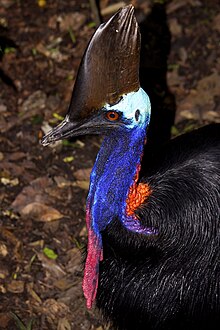The Palaeognathae, or paleognaths (from Ancient Greek palaió- "old" + gnáthos "jaw") is one of two living clades of birds: the other is the Neognathae. Together, the two clades make up the clade Neornithes.
| Paleognaths Temporal range: | |
|---|---|
 | |
| Southern cassowary (Casuarius casuarius) | |
| Scientific classification | |
| Domain: | Eukaryota |
| Kingdom: | Animalia |
| Phylum: | Chordata |
| Class: | Aves |
| Infraclass: | Palaeognathae Pycraft, 1900 |
| Orders | |
| |
Palaeognathae includes five living branches of flightless birds (plus two extinct clades), called ratites, and one flying lineage, the Neotropic tinamous.[1][2] There are 47 species of tinamous, five of kiwis (Apteryx), three of cassowaries (Casuarius), one of emus (Dromaius) (another emu became extinct in historic times), two of rheas (Rhea) and two of ostriches (Struthio).[3]
Recent research has shown that palaeognaths are monophyletic but the traditional taxonomic split between flightless and flighted forms is incorrect. Tinamous are within the ratite radiation. Flightlessness arose independently a number of times by parallel evolution.[4]
There are three extinct groups that are undisputed members of Palaeognathae: the Lithornithiformes, the Dinornithiformes (moas) and the Aepyornithiformes (elephant birds).
References
Wikiwand in your browser!
Seamless Wikipedia browsing. On steroids.
Every time you click a link to Wikipedia, Wiktionary or Wikiquote in your browser's search results, it will show the modern Wikiwand interface.
Wikiwand extension is a five stars, simple, with minimum permission required to keep your browsing private, safe and transparent.
